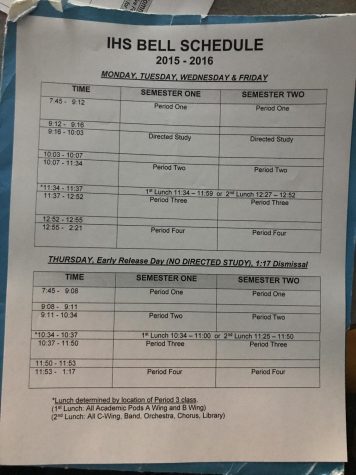The Scheduling Debate: Making the Best Use of your Time
December 19, 2018
Every school wants to be at the top, providing their students with the best education possible. Some characteristics defining the “best” schools are those with the most resources, the highest test scores and lowest dropout rates. Numerous other factors come into play when evaluating a school’s academic success. Back in 2016 school administrations at Ipswich High made a radical change in attempt to improve student learning, transitioning from the four by four block schedule to the seven period rotating waterfall schedule.
The block schedule is more more like the “typical college schedule,” allowing students to finish classes in a semester as opposed to a year. Only 30% of American high schools still use this schedule. At Ipswich High, the block schedule consisted of four 90 minute classes everyday for half a year, with one 50 minute year long class. Students took either two or three academic classes a semester, and one elective every quarter.
Ipswich High joined the majority of American public schools when they switched to the seven period waterfall schedule. Approximately 70% of American public schools use a form of this scheduling. At Ipswich, this schedule consists of five daily 75 minute periods every other day. Under this schedule, students take five academic courses year long with four semester long electives.
The debate between block scheduling and traditional scheduling is not a new one. Factors that were looked at when determining the advantages of one over another include learning gaps, teaching efficiency, time management benefits, and economic costs.
For Ipswich, the change was inevitable. The school committee had been looking to switch over for years, finally settling on a form of the traditional seven period rotation schedule.
Mr. Sargent is a 10 year teaching veteran here at Ipswich High and is a proponent of the seven period schedule. He believes there are still improvements that could be made for not every schedule is perfect, but in his opinion this schedule is definitely better than the block schedule.
The number one disadvantage he saw with the block schedule was that you didn’t get to build meaningful relationships with students yearlong. Only seeing students half year also produced concerns regarding gaps in learning. For students could go up to a year without a core subject. This became a main concern for the math and language departments as these subjects often build upon previous year’s material. Another concern regarding half year classes had to do with standardized testing preparation. Not having a core class such as math on a consistent basis was assumed to weaken the skills needed for standardized tests such as MCAS. At Ipswich High, Sargent notes that have seen a consistent rise in MCAS scores in years since the switch was made but there are many other variables that could have contributed to this rise. From the statistics side of things, Sargent believes there is not enough data to support one schedule over the other.
Despite lacking statistical evidence to prove or disprove the schedules affect on academic success, Sargent continues to advocate for the seven period schedule for other reasons. As an AP teacher, he mentions another huge disadvantage with the Block schedule for AP classes: the time crunch. Already fast and intensive courses, the intensity increases as AP courses are forced to fit all of their curriculum in half a year. To try to make up for lost time students would be required to attend either fall or spring seminars during their resource blocks, but this simply wasn’t enough. Sargent states “APs are meant to be year longs.”
A main argument for the block schedule is that it allows teachers to cover more in depth content and students are more engaged. Sargent believes this is not the case for “you can only teach so much” and “students can only learn so much” in a class period. He has not seen a drastic change in the amount his students focus and his teaching style has not been radically changed by the switch.
Economically, there is an argument that the seven period schedule is more costly, for now double the textbooks must be bought to provide for all students taking the course over the year. Mr. Sargent believes this is not a huge deal though for these added costs are not super significant. Afterall, wouldn’t we want to spend a little more to make our students perform better?
From the student side of things, Senior Zach Forni has experienced both schedules agreeing with Sargent that the seven period schedule is better. While he does believe that the old schedule gave him less homework, the new schedule is better for studying. Zach reasons that “since you don’t have class everyday you can see your teachers for extra help on your non class days.” The new schedule also “gives you more time to get work done.” Having classes everyday was “crazy tedious” to Zach and only having classes three times a week gives you a mental break.
In addition to seeing the benefits of having classes less frequently throughout the week he also sees a benefit to having shorter periods. He says “I would always completely check out when I saw we still had 20 minutes left in class,” and feels he definitely focuses better with shorter periods.
From the standpoint of Sargent and Zach, the seven period schedule appears to be the winner, trumping the block schedule in numerous ways. As readers I now ask you to rely on your own opinions and weigh the cost-benefits for yourselves. Which schedule do you believe is truly the best?

